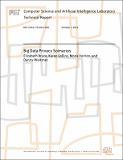Big Data Privacy Scenarios
Author(s)
Bruce, Elizabeth; Sollins, Karen; Vernon, Mona; Weitzner, Danny
DownloadMIT-CSAIL-TR-2015-030.pdf (1.633Mb)
Other Contributors
Advanced Network Architecture
Decentralized Information Group
Advisor
Karen Sollins
Danny Weitzner
Terms of use
Metadata
Show full item recordAbstract
This paper is the first in a series on privacy in Big Data. As an outgrowth of a series of workshops on the topic, the Big Data Privacy Working Group undertook a study of a series of use scenarios to highlight the challenges to privacy that arise in the Big Data arena. This is a report on those scenarios. The deeper question explored by this exercise is what is distinctive about privacy in the context of Big Data. In addition, we discuss an initial list of issues for privacy that derive specifically from the nature of Big Data. These derive from observations across the real world scenarios and use cases explored in this project as well as wider reading and discussions:* Scale: The sheer size of the datasets leads to challenges in creating, managing and applying privacy policies.* Diversity: The increased likelihood of more and more diverse participants in Big Data collection, management, and use, leads to differing agendas and objectives. By nature, this is likely to lead to contradictory agendas and objectives.* Integration: With increased data management technologies (e.g. cloud services, data lakes, and so forth), integration across datasets, with new and often surprising opportunities for cross-product inferences, will also come new information about individuals and their behaviors.* Impact on secondary participants: Because many pieces of information are reflective of not only the targeted subject, but secondary, often unattended, participants, the inferences and resulting information will increasingly be reflective of other people, not originally considered as the subject of privacy concerns and approaches.* Need for emergent policies for emergent information: As inferences over merged data sets occur, emergent information or understanding will occur. Although each unique data set may have existing privacy policies and enforcement mechanisms, it is not clear that it is possible to develop the requisite and appropriate emerged privacy policies and appropriate enforcement of them automatically.
Date issued
2015-10-01Series/Report no.
MIT-CSAIL-TR-2015-030
Keywords
Big Data, Use scenarios, Privacy